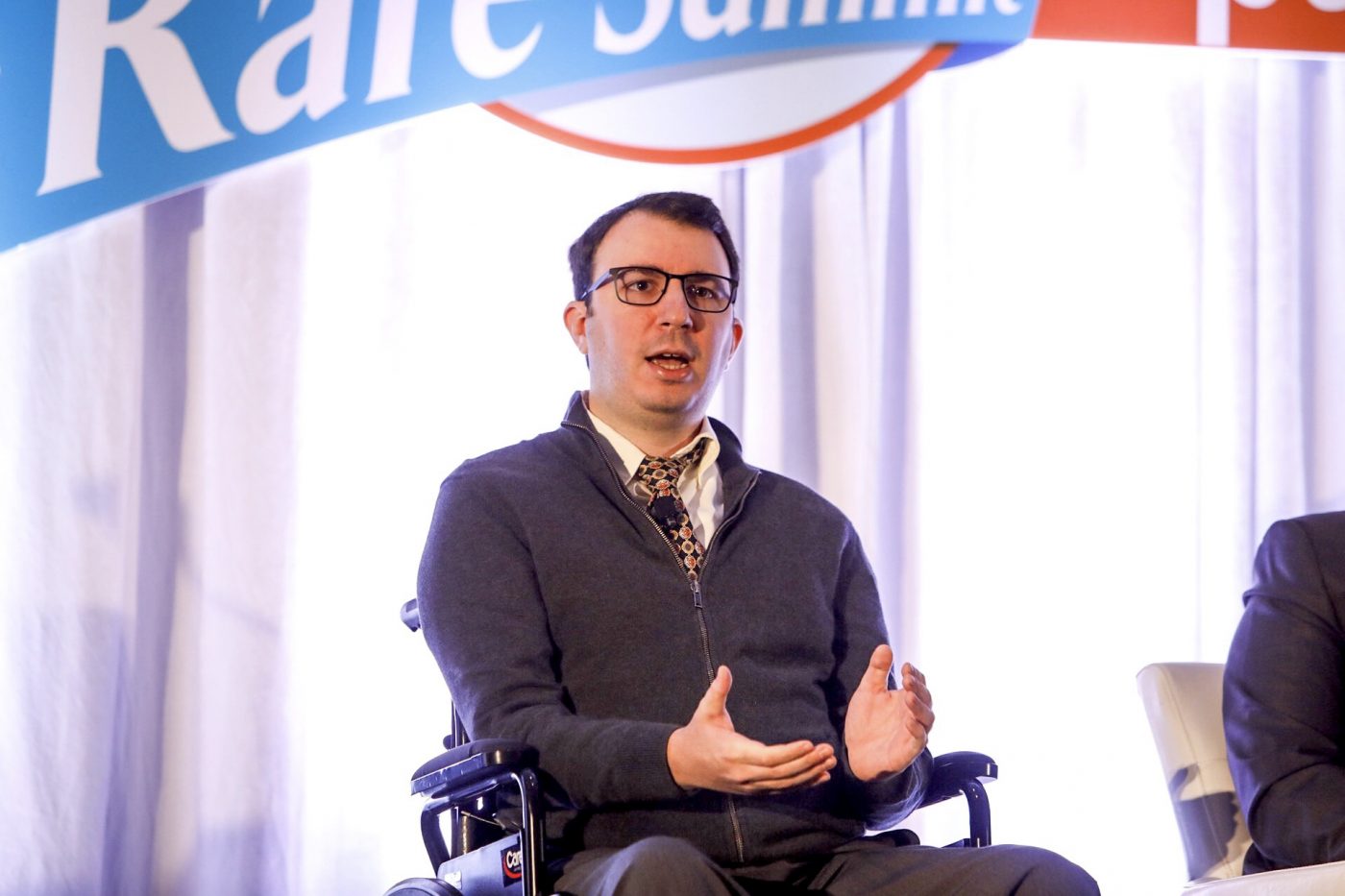Connecticut Man With Limb-girdle MD Inspires Others

LGMD patient Christopher Anselmo, 32, speaks at the recent NORD summit in Washington, D.C. (Photo by John Boal/NORD)
If it weren’t for a serious auto accident during his senior year of high school, Christopher Anselmo might have had to wait many more years before discovering he had limb-girdle muscular dystrophy (LGMD).
This rare condition — a general term for more than 30 muscle-wasting conditions — affects anywhere from one in 14,500 to one in 123,000 people. But Anselmo’s form of LGMD, known as type 2B or disferlinopathy, is even more rare. Worldwide, only a few hundred people have been identified as having this particular autosomal recessive genetic disorder, which results from a patient having inherited both defective dysferlin gene copies, one from each parent.
Typically, patients begin experiencing gradually worsening muscle weakness in their early 20s, with high serum levels of creatine kinase (CK), a marker of muscle damage. About one-third of these patients need wheelchairs within 15 years of the onset of symptoms; yet, unlike Duchenne, it does not affect the heart muscle.
“There’s such a variability in physicians around the country and their knowledge of rare diseases,” he recently told Muscular Dystrophy News Today. “I was lucky that one of the first doctors I saw actually knew about my condition. So many people go their entire lives without getting a proper diagnosis.”
But in the case of Anselmo, now 32, that diagnosis came early thanks to his car crash.
“We got T-boned by a pickup truck, and I was in the passenger seat. I had cracked ribs but no broken bones,” recalled the resident of Westbrook, Connecticut. “I was lucky, and was about to be discharged from the hospital when a routine blood test showed very abnormal levels of CK.”
Join the MD forums: an online community especially for patients with Muscular Dystrophy.
At the time, doctors thought Anselmo had suffered an internal injury, but couldn’t find anything wrong with him so they sent him to an endocrinologist, a rheumatologist and a neurologist.
Anselmo: ‘A very odd diagnosis’
“Over the course of 11 months, they determined I had missing dysferlin,” said Anselmo, who blogs at Sidewalks & Stairwells. “They said, ‘You have a muscle disease,’ which shocked me since I had no symptoms. It seemed like a very odd diagnosis to have. My impression was that it wouldn’t happen until later in life, when there’d be some sort of treatment.”
Not giving it another thought, Anselmo attended Boston’s Northeastern University and earned a bachelor’s degree in marketing.
“A few weeks after graduation, in June 2008, I was going for a run and my leg started burning. I thought that was weird,” said Anselmo, who had played basketball growing up. “Then one day, I noticed that going up steps wasn’t as easy as it used to be. I started getting tired easily. Then I moved to a new apartment and found myself struggling to carry a desk chair up the stairs. By the time I got to the second floor, I was exhausted.”
Anselmo saw a pattern emerging, and consulted a Boston neurologist who confirmed his LGMD diagnosis. A subsequent blood test showed that his CK level was still in the tens of thousands.
A year later, Anselmo suffered his first fall.
“I was walking to the grocery store and my knee hit the sidewalk. I just crumpled to the ground,” he recalled. “I was constantly comparing myself to my friends and their careers, and I was worrying if I could make it to work without falling. As I continued to get weaker, I started lashing out at my friends, because I couldn’t really accept what was happening to me.”
In 2013, Anselmo was forced to re-evaluate the direction in which his life was heading.
Hope for the future
“One weekend, I was thinking about all the different goals I had,” he recalled. “I took out a piece of paper and wrote down everything I wanted to do in life: go to business school, write a book, work for an organization that was meaningful to me. I forced myself to think about the logistics of making it work, and I realized that, although I was getting weaker, I could still make it happen.”
Anselmo eventually got his MBA from Boston College, graduating in 2016.
For nearly half a year, Anselmo, 32, has been working full-time from Connecticut as market intelligence manager for the New York-based Muscular Dystrophy Association. As such, he regularly conducts research on pharmaceutical and biotech companies.
Yet he himself doesn’t take medications of any kind. The only pharma currently pursuing treatments for LGMD is Myonexus Therapeutics, which has five potential gene therapies in its pipeline.
Meanwhile, he said, “I can still walk distances, though I can’t get out of a chair by myself. I don’t have a lot of upper-body strength left. Writing is getting a little more difficult, though my typing is still pretty good. There have been no cognitive symptoms, but obviously it’s been difficult emotionally.”
Despite his frustrations, Anselmo says the new scientific breakthroughs in rare diseases occurring every day — especially with gene therapy — give him hope. LGMD patients who have gone for years without a diagnosis are finally receiving confirmations of their conditions.
“I owe a lot of credit to my support system and my family and friends, who pick me up when I fall,” said Anselmo, adding that despite his introverted nature, it brings him great joy to make friends. “It’s so powerful to share one’s story. You may not think you’re going through anything special or noteworthy, but for somebody out there, you’re living their exact experience.”







